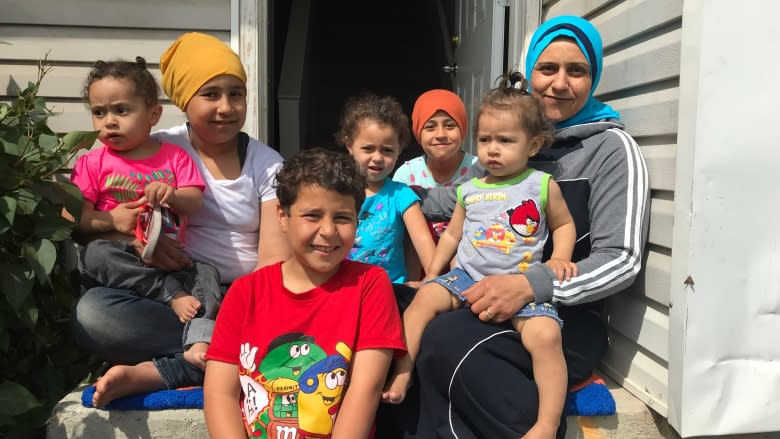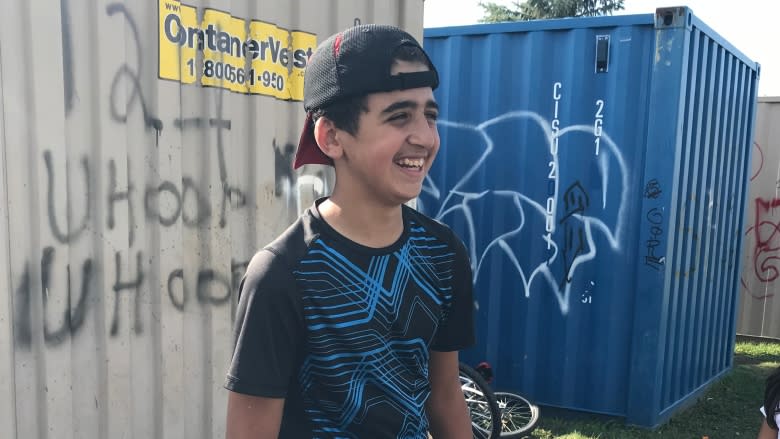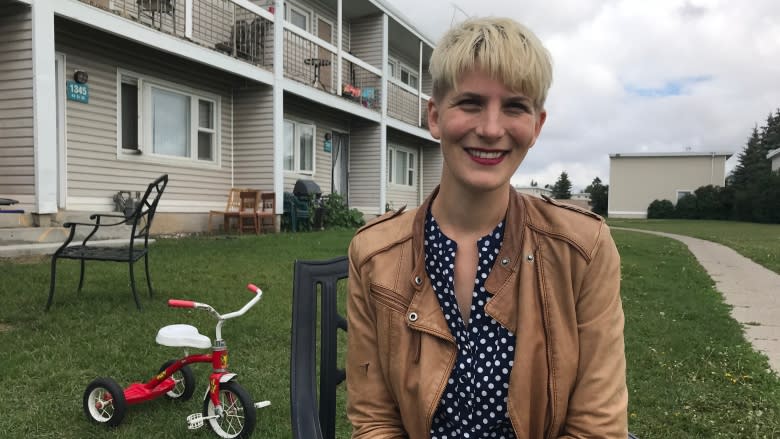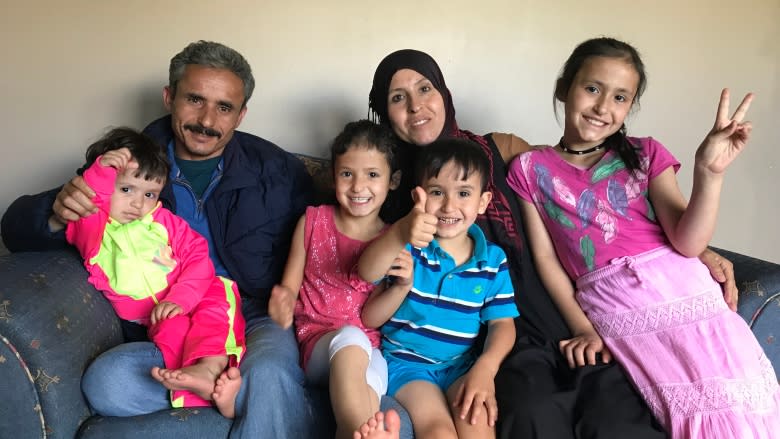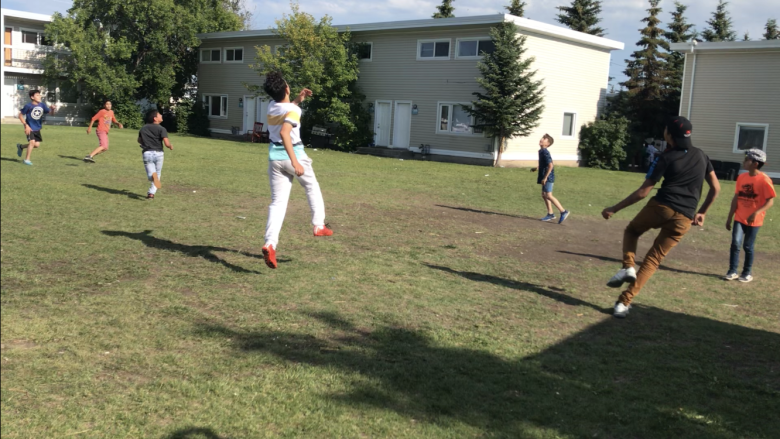Design and makeup of 'Little Syria' ideal for resettlement, says Calgary-based researcher
The sun is starting to dip behind the tall, row houses in this townhouse complex in the southeast Calgary community of Forest Lawn, casting a shadow on the heart of what has become known as 'Little Syria' or 'Syria Town.'
A group of about 15 boys from Syria and Lebanon play soccer in a green space that cuts through the middle of the complex. Oday Alomare, 14, who is playing goalie, uses the end of a metal shipping container as a backstop.
"So much friends here," said Alomare. " "We play with lots of kids."
Elsewhere, a few girls — one wearing a white hijab — ride their bikes along the path that winds between the houses.
And a trail of younger boys pull a round, black plastic toboggan down the sidewalk, giving one of their mates a loud and bumpy ride.
About 35 government-sponsored Syrian refugee families now call 'Little Syria' home.
"I see my friends and I see beautiful houses, " said Rawaa Abodanfe, 11, standing on her front step, wearing a white T-shirt, jeans and an orange hijab.
She is the oldest of six kids. She says she feels safe here. Much different than what she remembers about her life back in Syria.
Settlement research
Bronwyn Bragg, an urban geography PhD graduate student at the University of British Columbia, has spent the past 18 months speaking with families in this four-block, mini-enclave of Syrian refugees to study the way geography affects settlement, their sense of belonging and the reshaping of neighbourhood life.
"I would say that overall, a major draw to living in this area is the fact that people are able to be with ... other people who share a similar experience with them. And I think that's especially important for refugees who have this experience of displacement, tremendous dislocation," she said.
Bragg wanted to explore the perception by some that keeping refugees together in isolation would hinder their integration. She says that perception is based on fear from rising Islamophobia around the world.
"Like 'Oooh, I'm not sure if people living together, these newcomers, maybe it would be better if they were separated from each other and they would integrate more rapidly,'" she said.
But she says she is skeptical of that assumption.
Plus, she says 'Little Syria' is different.
Even though it contains the highest concentration of Syrian refugees in Calgary, which allows them to develop a base of support among their peers, they are dispersed among a large, housing complex filled with a diverse community of refugees and immigrants from other countries, Indigenous people, and Canadians.
And that's allowing them to create broader, social connections.
"So the neighbour that's next door that's Canadian, maybe they're helping me look at this document that I don't understand and they're translating it for me," she said. "Our kids are going to the same school. They're playing together."
On top of that, she says, the housing complex is located within Forest Lawn, an extremely diverse community with some of the best settlement resources in the city.
"And I think what's important in terms of integration is actually feeling a sense of social support and community wherever that's coming from because that gives people the confidence to say, 'Okay, I'm here, I'm supported here, and I can take that next big step whatever it is, learning English, getting a job, going to parent teacher interview at my kid's school,'" she said.
"It's when people are really isolated and feel alone that I think we should be more worried about this question of integration and belonging."
'All here, friends'
Mohammad Al Mohamad opens his door and welcomes me into his three bedroom townhouse where he lives with his wife and five children. They are expecting another child in October. I sit on a blue cloth loveseat. Mohamad sits across from me. His wife settles in beside him. Their children jump up on the cushion next to me, carefully watching, and smiling.
Mohamad says he's thankful to have so many families from Syria living close by.
"All here, friends," he said.
"And my kids like this area because be with friends. And neighbours, long time here live, they like the area. And me, my school here, five-minutes walk. Everything here. I feel safety. Nothing is a problem here."
Nearby, there's an Arabic bakery, a Halal store, and a shopping mall.
And most of the time, he says he's happy, especially when he's with his children.
But he says his heart hurts when he thinks about his brother who is still living in Lebanon. That's where their families fled to after the war started in Syria.
"When I study, my mind not here, I need someone from my family near me or talking with me," said Mohamad.
He says his mother, father and brother were his community. Now he must learn to build a new one here.
After three years, he says his new-found relationships are getting stronger.
"If I have trouble, or my wife sick, I want to take her to hospital, I put my kids in with my friend," he said.
Little Syria's reputation
Bragg says Little Syria has grown since the first wave of folks started arriving during the refugee crisis in 2015. She says the community's reputation as a warm and welcoming place is spreading to other parts of Calgary, and Canada.
"I've interviewed families who have moved here from Vancouver and Quebec who live here, who wanted to not move to Calgary, but wanted to move to Little Syria in Forest Lawn because they heard about it," she said. "They met someone on the plane coming over, from Lebanon or Jordan ... so it does draw people in and together."
But she says three years in, she is starting to notice that some Syrians are expressing a desire to move to another neighbourhood, or another home within the neighbourhood, but they are held back because of a lack of affordable housing options.
"Perhaps we're entering a period where some folks would like to maybe just experience a different dynamic, a different way of living in Calgary, but there's challenges about where do you go from here because of that size of family, housing cost, ratio," she said.
Mohamad says sometimes he thinks about moving to a bigger place with a yard but then he talks himself out of it.
"I go to looking for another house, separate, but you need too expensive," he said.
Rawaa Abodanfe says at one point, her family also desired a larger home.
They moved to the northeast community of Castle Ridge, but ended up coming back to Little Syria for a few reasons.
"We didn't have friends, we want to play with each other," said Abodanfe. "Not that safe, we would put stuff out ... somebody [would] steal it."
And she hopes to make even more friends — specifically with kids from other countries.
Bragg says her research should be complete in six months. In the meantime, she's providing information to local service
providers to help them help the refugee.
- MORE ALBERTA NEWS | 'Gas bar shenanigans' spike prices across Alberta, analyst says
- MORE ALBERTA NEWS | Katimavik is back opening minds and teaching reconciliation, Calgary volunteer says
- Read more articles by CBC Calgary, like us on Facebook for updates and subscribe to our CBC Calgary newsletter for the day's news at a glance.

